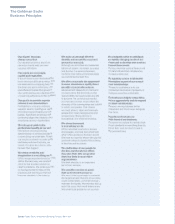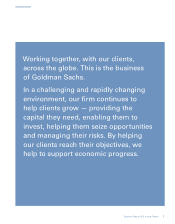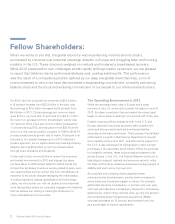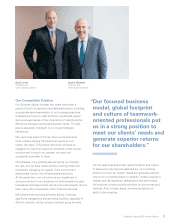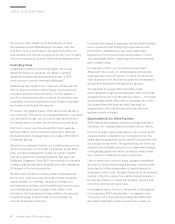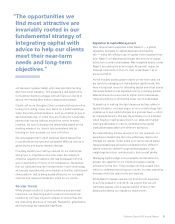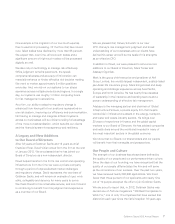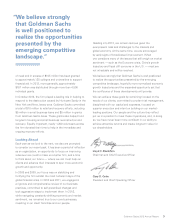Goldman Sachs 2012 Annual Report Download - page 6
Download and view the complete annual report
Please find page 6 of the 2012 Goldman Sachs annual report below. You can navigate through the pages in the report by either clicking on the pages listed below, or by using the keyword search tool below to find specific information within the annual report.
4Goldman Sachs 2012 Annual Report
Letter to Shareholders
In another area related to expenses, we have demonstrated
a strong commitment to aligning compensation with
performance, establishing a very close relationship
between the firm’s revenue and compensation. In short,
we compensate better in good years and have restricted
pay in weaker ones.
For example, in 2011, our net revenues were down
26 percent. As a result, our compensation and benefits
expenses were down 21 percent. In 2012, net revenues
rose 19 percent from the previous year and compensation
and benefits expenses increased by six percent.
Our approach to compensation flexibility is also
demonstrated through our compensation ratio, which has
averaged 39 percent over the past four years — more than
six percentage points lower than our average ratio in the
four years before the financial crisis. Last year, our
compensation ratio was the second lowest since we
became a public company.
Opportunities & Our Client Franchise
While tactical and strategic actions are always important,
ultimately, our success begins and ends with our clients.
It is only through ongoing discussions with our clients that
we gain a better understanding of emerging trends, the
challenges and goals that are our clients’ focus and the role
we can play to help them. The opportunities we find most
attractive are invariably rooted in our fundamental strategy
of integrating capital with advice to help our clients meet
their near-term needs and long-term objectives.
Like no other time in recent history, access to diversified
sources of funding is becoming a strategic imperative and
is driving the further development of capital markets in
many parts of the world. Roughly 70 percent of all corporate
funding in the U.S. comes from capital markets activity; in
Europe, the situation is nearly the opposite, with the bulk
of funding coming from bank loans.
In leveraged finance, however, 58 percent of the issuance
in Europe since 2010 were bonds — compared to just
14 percent in the three years preceding the 2008 crisis.
We expect that higher capital requirements, which we
As we have often stated, our businesses do not lend
themselves to predictable earnings. However, over the
long term, we are committed to the goal of providing our
shareholders with returns on equity at the top of our industry,
while continuing to grow book value and earnings per share.
Controlling Costs
A significant element of providing healthy returns is a
disciplined focus on expenses. Our ability to achieve
operating leverage was particularly important in 2012
when economic growth remained challenged.
Markets, by their construction, reflect the natural ebb and
flow of economic activity, which means moving between
periods of expansion and contraction. For this reason, it
should not be surprising that in a period of contraction and
uncertainty we would experience lower levels of corporate
and investor activity and risk appetite.
Of course, we respect cycles, which can sometimes last a
very long time. They can be so consequential that, if one does
not react early enough, you not only forego the benefits of
the cyclical upturn, but also risk the ability to recover at all.
With this in mind, we announced a $1.2 billion expense
savings initiative with our second quarter 2011 earnings.
We subsequently increased that to a run-rate of $1.9 billion
in expense savings.
As part of our expense initiative, our overall headcount was
down nine percent over the past six quarters. At the same
time, we have increased the number of people in certain
high value locations, including Bangalore, Salt Lake City,
Dallas and Singapore. Since 2007, the number of our people
in these locations has nearly doubled, and today represents
23 percent of the firm’s population.
We also have focused on closing certain businesses that
are not core, have lower returns and/or impose excessive
capital charges. For example, we sold our hedge fund
administration business, which provides various accounting
and processing services to hedge funds. Many of the
activities in that business were less central to the services
we provide hedge funds through prime brokerage, an
important business for the firm.


